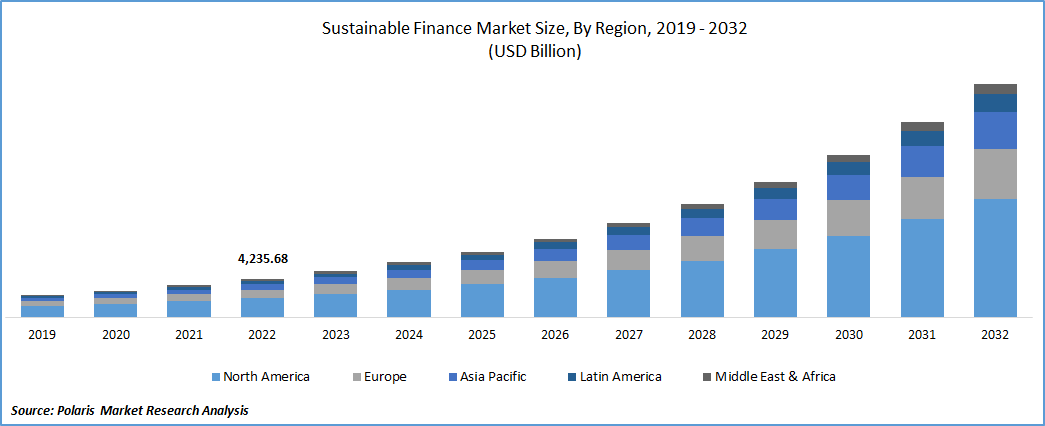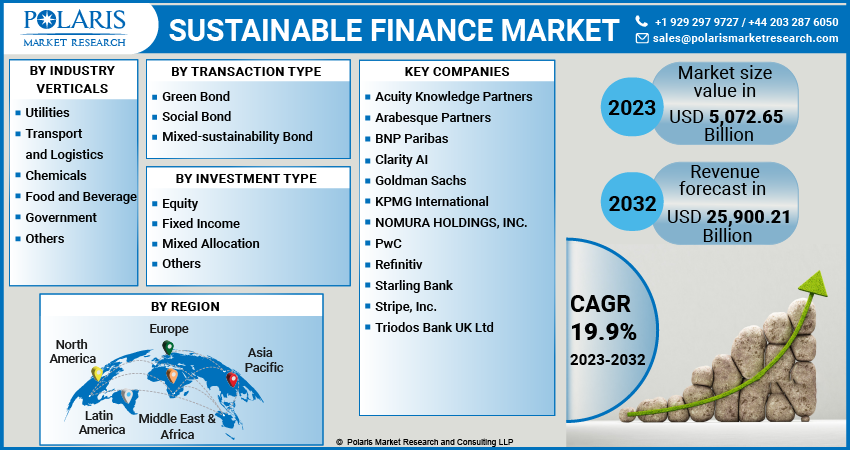
Sustainable Finance Market Share, Size, Trends, Industry Analysis Report, By Investment Type (Equity, Fixed Income, Mixed Allocation, Others); By Transaction Type; By Industry Verticals; By Region; Segment Forecast, 2023 - 2032
- Published Date:Jul-2023
- Pages: 118
- Format: PDF
- Report ID: PM3658
- Base Year: 2022
- Historical Data: 2019-2021
Report Outlook
The global sustainable finance market was valued at USD 4,235.68 billion in 2022 and is expected to grow at a CAGR of 19.9% during the forecast period.
Sustainable finance is financial activities that integrate environmental, social, and governance (ESG) considerations into investment decision-making and capital allocation. It involves directing financial resources toward projects, companies, and initiatives that promote sustainable development, address environmental challenges, and contribute to positive social outcomes.
The research study provides a comprehensive analysis of the industry, assessing the market on the basis of various segments and sub-segments. It sheds light on the competitive landscape and introduces sustainable finance market key players from the perspective of market share, concentration ratio, etc. The study is a vital resource for understanding the growth drivers, opportunities, and challenges in the industry.

To Understand More About this Research: Request a Free Sample Report
The key objectives of sustainable finance are to align financial flows with sustainable goals, support the transition to a low-carbon and climate-resilient economy, and promote social equality and responsible business practices. It aims to achieve both financial returns and positive environmental and social impacts.
Investments in sustainable businesses are on the rise, driven by increasing demand for finance professionals in sustainable finance. Sustainable finance offers cost reduction, risk mitigation, and improved returns while reducing exposure to sustainability-related risks. However, diversification challenges and high operating costs limit market growth. Nonetheless, growing sustainability awareness among sectors presents lucrative opportunities in the sustainable finance market.
The demand for finance professionals specializing in sustainable environmental, social, and governance (ESG) practices is rapidly increasing as investments in businesses and projects with sustainable ESG practices increase.
- For instance, in February 2021, the United Nations' Intergovernmental Panel on Climate Change emphasized the urgent need to integrate ESG factors, among others, into investment decisions to drive fast and impactful change for the environment.
Furthermore, industry leaders have demonstrated that reevaluating environmental and social performance can drive change that enhances business value and promotes positive outcomes for both people and the planet. It represents a significant driving force behind the market.
The COVID-19 pandemic had a mild impact on the market. Investors faced substantial losses due to high market volatility during this period. Consequently, they sought investment opportunities that offered higher returns with reduced risk. As a result, sustainable financing emerged as an attractive investment option due to its potential for better returns compared to traditional investments. Additionally, increased awareness of ESG sustainability among investors and consumers significantly influenced the market.

For Specific Research Requirements, Speak With a Resaerch Analyst
Industry Dynamics
Growth Drivers
Growing awareness of sustainability among various sectors
The growing awareness of sustainability among various sectors is significant from recognizing the environmental and social challenges our global society faces and the need to address them through financial mechanisms. There is an increasing understanding of the planet's ecological challenges, such as climate change, biodiversity loss, and resource depletion. These challenges have far-reaching impacts on ecosystems, human well-being, and the economy. As a result, businesses, investors, and policymakers across sectors recognize the importance of incorporating sustainability principles into their operations and investment decisions.
Alongside environmental concerns, there is growing awareness of social issues such as income inequality, labor rights, access to healthcare and education, and diversity and inclusion. Stakeholders, including customers, employees, and communities, demand greater accountability and responsible business practices. It has led businesses to integrate social considerations into their strategies and investors to seek investments that positively impact society.
Governments and regulatory bodies worldwide are implementing policies and regulations to address sustainability challenges. These include setting emissions reduction targets, promoting renewable energy, requiring ESG disclosures, and imposing penalties for non-compliance. Such regulatory measures incentivize businesses to adopt sustainable practices and encourage investments in sustainable projects.
Report Segmentation
The market is primarily segmented based on investment type, transaction type, industry verticals, and region.
|
By Investment Type |
By Transaction Type |
By Industry Verticals |
By Region |
|
|
|
|
To Understand the Scope of this Report: Speak to Analyst
By Investment Type
The fixed income segment accounted for the largest market share in 2022
In 2022, the fixed-income segment accounted for the largest market share in sustainable finance. Fixed-income instruments, such as green and sustainability-linked bonds, have been widely adopted and have seen significant growth in recent years. These bonds allow issuers to raise capital for sustainable and environmentally friendly projects.
The sustainable finance market is evolving rapidly, and the dominance of specific segments may shift over time. The equity segment, which includes sustainable or socially responsible investment (SRI) funds and impact investing, has also experienced significant growth as investors seek to align their investment portfolios with sustainability goals.
Furthermore, the mixed allocation segment anticipates significant growth, combining equity and fixed-income instruments, another important component of the sustainable finance. It allows for diversification across asset classes and investment strategies, combining the benefits of both equity and fixed-income approaches.
By Transaction Type
The green bond segment held the highest market share in 2022
In 2022, the green bond segment held the highest market share in sustainable finance, and this can be attributed to several factors that deliver benefits for both issuers and investors. Companies can access a dedicated pool of capital interested in financing environmentally friendly projects by issuing green bonds. It can diversify its funding sources and attract investors who prioritize sustainability. Green bonds can also enhance issuers' reputations by showcasing their commitment to environmental stewardship and responsible business practices.
Green bonds allow investors to align their investment portfolios with their sustainability goals. They offer a transparent and credible investment option, as the proceeds are dedicated to environmentally beneficial projects and are subject to reporting and verification standards. Green bonds can also help investors manage ESG risks and capitalize on transitioning to a low-carbon economy. Additionally, green bonds can contribute to portfolio diversification and offer pricing benefits due to strong investor demand and limited supply.
There is evidence of pricing benefits for some issuers in the green bond market. Strong investor demand for green bonds and limited supply can create favorable pricing conditions. Some issuers have experienced lower borrowing costs than conventional bonds due to the high demand and clear perception of green investments. This pricing advantage incentivizes issuers to tap into the green bond market.
Regional Insights
Europe dominated the largest market in 2022
In 2022, Europe dominated the largest market in sustainable finance. The region's strong performance can be attributed to integrating environmental, social, and governance (ESG) principles into business decisions and investment strategies. Sustainable finance in Europe encompasses various issues, including climate change mitigation, labor practices, and social equality.
One contributing factor to Europe's market dominance is the increasing mainstream adoption of sustainable fintech. Sustainable fintech platforms incorporate ESG considerations into their financial products and services, enabling individuals and businesses to make sustainable investment choices. The appeal of sustainable fintech has extended to emerging markets, partly driven by the financing needs arising from the COVID-19 pandemic, such as healthcare investments. Additionally, Europe has experienced a surge in climate-related borrowing, further boosting the region's sustainable finance growth.
Key Market Players & Competitive Insights
Introducing competitive insights into the sustainable finance provides a comprehensive analysis of the competitive landscape, key players, and their strategies to succeed in the industry. It offers valuable information to stakeholders, including investors, financial institutions, and policymakers, who seek to understand the dynamics and trends in the market.
Some of the major players operating in the global market include:
- Acuity Knowledge Partners
- Arabesque Partners
- BNP Paribas
- Clarity AI
- Goldman Sachs
- KPMG International
- NOMURA HOLDINGS, INC.
- PwC
- Refinitiv
- Starling Bank
- Stripe, Inc.
- Triodos Bank UK Ltd.
Recent Developments
- In June 2022, Ortec Finance announced a partnership with ESG Book to facilitate investor access to sustainability data and insights. The collaboration aims to enhance the availability and usability of ESG (Environmental, Social, and Governance) data, enabling investors to make more informed decisions regarding sustainable finance.
- In November 2021, GoldenSource and Arabesque announced a partnership to enhance buy- and sell-side access to ESG data. The collaboration enables GoldenSource's clients to utilize Arabesque's new solution, designed to assist investors in meeting the Sustainable Finance Disclosure Regulation (SFDR) requirements.
Sustainable Finance Market Report Scope
|
Report Attributes |
Details |
|
Market size value in 2023 |
USD 5,072.65 billion |
|
Revenue forecast in 2032 |
USD 25,900.21 billion |
|
CAGR |
19.9% from 2023 – 2032 |
|
Base year |
2022 |
|
Historical data |
2019 – 2021 |
|
Forecast period |
2023 – 2032 |
|
Quantitative units |
Revenue in USD billion and CAGR from 2023 to 2032 |
|
Segments Covered |
By Investment Type, By Transaction Type, By Industry Verticals, By Region |
|
Regional scope |
North America, Europe, Asia Pacific, Latin America; Middle East & Africa |
|
Key Companies |
Acuity Knowledge Partners, Arabesque Partners, BNP Paribas, Clarity AI, Goldman Sachs, KPMG International, NOMURA HOLDINGS, INC., PwC, Refinitiv, Starling Bank, Stripe, Inc., Triodos Bank UK Ltd |
In today’s hyper-connected world, running a business around the clock is no longer an option. And at Polaris Market Research, we get that. Our sales & analyst team is available 24x5 to assist you. Get all your queries and questions answered about the sustainable finance market report with a phone call or email, as and when needed.
FAQ's
key companies in sustainable finance market are Acuity Knowledge Partners, Arabesque Partners, BNP Paribas, Clarity AI, Goldman Sachs, KPMG International, NOMURA HOLDINGS, INC.
The global sustainable finance market is expected to grow at a CAGR of 19.9% during the forecast period.
The sustainable finance market report covering key segments are investment type, transaction type, industry verticals, and region.
key driving factors in sustainable finance market are growing awareness of sustainability among various sectors.
The global sustainable finance stent market size is expected to reach USD 25,900.21 billion by 2032
